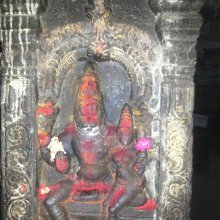Lakshminarasimha, Lakṣmīnarasiṃha, Lakshmi-narasimha: 5 definitions
Introduction:
Lakshminarasimha means something in Hinduism, Sanskrit. If you want to know the exact meaning, history, etymology or English translation of this term then check out the descriptions on this page. Add your comment or reference to a book if you want to contribute to this summary article.
The Sanskrit term Lakṣmīnarasiṃha can be transliterated into English as Laksminarasimha or Lakshminarasimha, using the IAST transliteration scheme (?).
Images (photo gallery)
In Hinduism
Pancaratra (worship of Nārāyaṇa)
Source: Wisdom Library: PāñcarātraLakṣmīnarasiṃha (लक्ष्मीनरसिंह) is short for Lakṣmī, one of the aspects of nṛsiṃha (‘man-lion’), according to the Vihagendra-saṃhitā 4.17. Nṛsiṃha is a Tantric deity and refers to the furious (ugra) incarnation of Viṣṇu. The Vihagendra-saṃhīta is a Sanskrit work from the 15th century and deals primarely with meditation on mantras and sacrificial oblations.

Pancaratra (पाञ्चरात्र, pāñcarātra) represents a tradition of Hinduism where Narayana is revered and worshipped. Closeley related to Vaishnavism, the Pancaratra literature includes various Agamas and tantras incorporating many Vaishnava philosophies.
Shilpashastra (iconography)
Source: Shodhganga: The significance of the mūla-beras (śilpa)Lakṣmī Narasiṃha is the name of a deity depicted at the Kallazhagar Temple in Madurai, which represents a sacred place for the worship of Viṣṇu.—Lakṣmī Narasiṃha is represented the same way as Bhūmī Varāha. But the face is that of a lion.

Shilpashastra (शिल्पशास्त्र, śilpaśāstra) represents the ancient Indian science (shastra) of creative arts (shilpa) such as sculpture, iconography and painting. Closely related to Vastushastra (architecture), they often share the same literature.
Languages of India and abroad
Sanskrit dictionary
Source: Cologne Digital Sanskrit Dictionaries: Aufrecht Catalogus Catalogorum1) Lakṣmīnarasiṃha (लक्ष्मीनरसिंह) as mentioned in Aufrecht’s Catalogus Catalogorum:—Vilāsa [grammatical]
2) Lakṣmīnarasiṃha (लक्ष्मीनरसिंह):—Viśeṣaṇadvayavaiyarthya [nyāya]
Source: Cologne Digital Sanskrit Dictionaries: Monier-Williams Sanskrit-English Dictionary1) Lakṣmīnarasiṃha (लक्ष्मीनरसिंह):—[=lakṣmī-nara-siṃha] [from lakṣmī > lakṣ] m. Name of a king, [Inscriptions]
2) [v.s. ...] of various authors, [Catalogue(s)]
[Sanskrit to German]
Sanskrit, also spelled संस्कृतम् (saṃskṛtam), is an ancient language of India commonly seen as the grandmother of the Indo-European language family (even English!). Closely allied with Prakrit and Pali, Sanskrit is more exhaustive in both grammar and terms and has the most extensive collection of literature in the world, greatly surpassing its sister-languages Greek and Latin.
See also (Relevant definitions)
Partial matches: Lakshmi, Simha, Narasimha.
Ends with: Vijayalakshminarasimha.
Full-text: Visheshanadvayavaiyarthya, Vilasa, Shatakotimandana, Narasimha Shalagrama, Lakshmi, Shalagrama, Mahabharatatatparyanirnaya.
Relevant text
Search found 6 books and stories containing Lakshminarasimha, Lakṣmīnarasiṃha, Lakshmi-narasimha, Lakṣmī-narasiṃha, Laksmi-narasimha, Laksminarasimha, Lakshminara-simha, Lakṣmīnara-siṃha, Laksminara-simha; (plurals include: Lakshminarasimhas, Lakṣmīnarasiṃhas, narasimhas, narasiṃhas, Laksminarasimhas, simhas, siṃhas). You can also click to the full overview containing English textual excerpts. Below are direct links for the most relevant articles:
Later Chola Temples (by S. R. Balasubrahmanyam)
Temples in Narasingapuram < [Chapter II - Temples of Kulottunga I’s Time]
Temples of Munnur (Historical Study) (by R. Muthuraman)
Other Images < [Chapter 5]
Middle Chola Temples (by S. R. Balasubrahmanyam)
Temples in Pasuvandanai < [Chapter II - Temples of Rajaraja I’s Time]
Temples in Marakkanam < [Chapter II - Temples of Rajaraja I’s Time]
Humour in Telugu Literature < [July 1967]
Humour in Telugu Literature < [July 1967]
A Fine Vijayanagar < [April – June, 1983]
Pallava period (Social and Cultural History) (by S. Krishnamurthy)
Vaishnavism during the Pallava period < [Chapter 3 - Socio-Religious Life]
Conclusion (Religious Beliefs and Customs) < [Chapter 5 - Conclusion]
Temples in and around Madurantakam (by B. Mekala)
